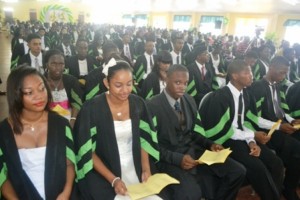
The Guyana School of Agriculture (GSA) this month celebrates its 50th anniversary since its opening. On September 9, 1963, then Agriculture Minister Brindley Benn signed the order establishing the GSA. When the GSA was established 50 years ago, it was as part of a plan to prepare Guyana for independence and to begin the modernisation of the country. Part of the package was an educational component.
Significance of agriculture
Former president, the late Dr Cheddi Jagan and the People’s Progressive Party (PPP) government at the time recognised the significance of agriculture in nurturing an economy with sustainable growth and a nation that was food and nutrition-secured. The GSA was established to ensure Guyana’s agriculture sector was the pillar on which the country’s economic fortunes were built.
The human capital development programme saw the establishment of the University of Guyana (UG), and this year the institution also celebrates its 50th anniversary. Today, Guyana’s doctors, teachers, lawyers, engineers, accountants, managers, pharmacists, medical technologists, nurses and other professionals are graduates of UG.
There was one other plank in the plan for building human capital through education and training in Guyana. Dr Jagan and the PPP realised that the country must offer its children secondary education – the quest for universal education for Guyanese children became a part of the plan which began implementation 50 years ago.
Public secondary schools in many regions of Guyana opened their doors around that time, 50 years ago.
It was the first time that the children of poor Guyanese families were able to gain access to secondary education.
Before that, there were only a handful of secondary schools in Guyana and most of these were private, fee-paid schools.
By 1990, secondary school education was only available to about 35 percent of Guyanese children who were eligible to attend high school.
Today, because of the visionary leadership of Dr Jagan and the PPP, more than 90 percent of children in Guyana have access to secondary school education.
It was also around that time, 50 years ago, that the teachers training college started as an in-service programme, with teachers training being done at various places at evening classes around the country. At the time, most of Guyana’s teachers were untrained. Less than five percent of teachers then had any training. Today almost 60 percent of Guyana’s teachers are trained.
Another component of the package of development initiatives resulting from the vision of Dr Jagan and the PPP was building an industrial base. Few realised that the industrialisation of Guyana was started by the establishment at the time of the first ever industrial park in Guyana – the Ruimveldt Industrial Park.
This is one of the earliest, if not the first of the industrial parks in the Caribbean. Today, most of Guyana’s giant industries are still operating from that site. Consider Banks DIH, Kissoon’s Group of Companies, Continental and Beharry Group of Companies. They all started out of the first industrial park.
There were other parts of the package for the modernisation of Guyana, preparing it for independence. Dr Jagan started agricultural settlements such as Black Bush Polder, Canal Polder, Tapakuma and Mara and established irrigation infrastructure such as Dawa, Mibikuri and Manorbishi pump stations.
These today are critical elements in the growth of agriculture in Guyana, providing a sustainable base for the growth of the economy and creating jobs for people.
Transport sector
It was about this time too that Dr Jagan initiated an improvement of the transport sector by expanding the ferry services in Guyana through the construction of ferry boats locally. The ‘Torani’ and other boats which still ply Guyana’s rivers, were constructed about 50 years ago.
Every modern country had to have a hotel industry. Guyana’s first international hotel – the Pegasus – started about this time too. People questioned then, too, if Guyana needed an international hotel. But the Pegasus also is about 50 years old now, although it continues to serve.
But Dr Jagan and the PPP also recognised that a financial infrastructure must be established to support the creation of a nation and to support the country as it moves from being a low developing country to a middle-income country. Guyana’s Bank of Guyana started about 50 years ago too.
Around 50 years ago, through vision and bold leadership, the modernisation of a nation started. It is unfortunate that political machination in Guyana by the U.S. and the UK with local politicians resulted in slowing down that first modernisation thrust.
Development
Since 2001, another such period of rapid development has been taking place, initially led by former President Bharrat Jagdeo.
The building of the Berbice, Mahaicony and Mahaica Rivers bridges, the expansion of highways and bridges, the construction of a ferry service to Nikerie, the construction of the UG campus, the construction of the Takatu Bridge, construction of a stadium, an aquatic centre, an athletic track, an improved airport, the upgrading of the Ogle Aerodrome and many others have poised Guyana to become a modern state.
But the work is not complete. Guyana needs to complete the Amaila Falls Hydro Electricity Project (AFHEP), the Marriott Hotel initiative, and the Cheddi Jagan International Airport (CJIA) expansion project. The country must be bold and visionary, just like Dr Jagan was when he started those initial transformative projects 50 years ago.



